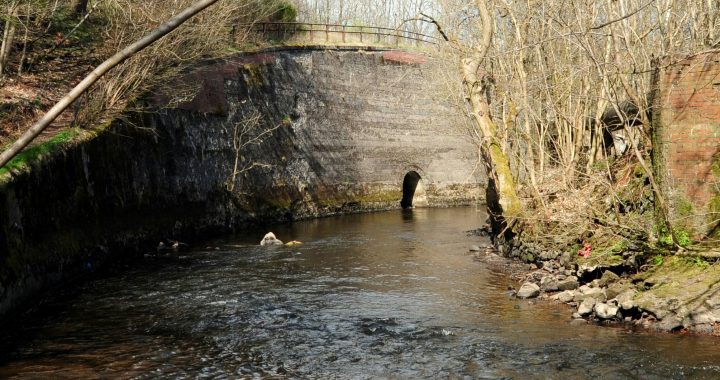Continuing our journey down the Black Cart.
Opposite the site of Johnstone Old Cotton Mill, is an arch in the high stone retaining wall supporting the former railway (now the cycle path). This marks the entry of the Kilbarchan Burn into the Cart. (See image above.)
The burn rises in bogland on Marshall Moor. Above the village, it passes through Glentyan Estate, where it has been dammed to create a large pond and high level lade, passing over ornamental cascades. This pond was party to store water to drive Glentyan Mill. However it also seems to have been diverted south of Bank Brae to the bleachfields in the centre of the village (see below).Glentyan Mill was a traditional grain mill of which ruins survive.
Although famed for its weaving industry, Kilbarchan is one of the only Renfrewshire villages not to have a big cotton mill. The nearest cotton mill to the village was at Cartside. A relatively late proposal to erect a large steam powered cotton mill nearer the village in 1825 never emerged.
However Kilbarchan did make innovative use of its water resources. Just downstream from Glentyan mill was a water powered thread mill in a converted house built over the burn by James Alexander in 1756. The previous year Alexander had invented a machine ‘to go by water for twining thread’ and received a grant of twenty pounds from The Board of Trustees for Manufacture. Alexander’s house is shown on Roy’s map of 1755, situated west of the kirkyard directly on the Kilbarchan Burn. This linen thread mill can lay claim to being the first water-powered thread mill in Scotland.In the heart of the village in the 1780s were at least six bleachfields which bleached the fine textiles which had been hand woven in the village. These bleachfields were located in the Bog Park, although only scant evidence remains today.
Downstream of the village there is a tradition of another mill in the Victorian period. Beyond this, the lower parts of the burn pass through Milliken Estate, where the burn was straightened and passed over cascades supplying ponds, before entering the Black Cart at Johnstone.
© 2017, Stuart Nisbet, Renfrewshire Local History Forum

